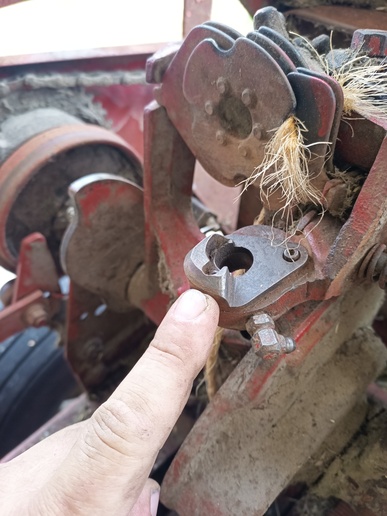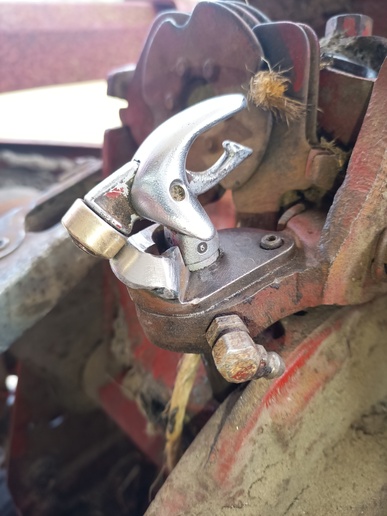Hello everyone,
I'm hoping I can learn from the hard earned wisdom of others here. I'm using an old New Holland 275 (1965-1971) baler, which for years has been a solid baler where it'd only miss a knot for the first
bale or two a year with a clean chamber and once it got going it was a joy to use. Unfortunately, last summer it just suddenly stopped making proper knots on the left knotter. Since it was so close to the
end of the year I just hopped off to hand tie the left side to finish the field. I noticed when forcing a knot while turning the baler over by hand that the bill hook seemed to only grab half the twine
(Sisal 7200, never had great luck with the 9000 or smaller diameter twine rolls). There was some wear on the bill hook pinion flat, so I swapped out the pinion and before this first field checked out the
twine fingers, discs, needles etc. I've got it hitting about 80% of the bales, but that's still too many missed knots and mess to clean up.
So in a nutshell, it now *looks* like it ties properly 100% of the time, but when you tug on the twine for a knotted bale, the left knot seems like it's not tightened and the twine can slide enough to come
undone, so it's like it's knotting 100% of the motion, but not completely tight that 20% of them can open up.
So the #1 twine in the disc - no issues here, the disc always holds the #1 twine, and even on the knots that come undone, the #1 twine is always knotted.
When the needles come up, they look like they're in a good position and they're placing the twine into the slot on the twine disc. Since there's always a #1 twine present on every bale and the #1 is
knotted, I don't think needle placement has anything to do with this issue.
The fingers are rotating into place, and both #1 and #2 twine are placed next to each other over the billhook.
The billhook rotates with both twines in the correct place, and it goes through the motion of making the knots - and it seems to me that its somewhere in this motion where things must be going a bit off.
There's not really any adjustment here except that one locknut with a spring on it for the arm that the billhook roller bearing rides on. I suspect that the twine may be tearing at the billhook rather than
the knife leading to a short tail that can pull out (the twine tail doesn't always look like a straight cut) but I can't seem to find any burrs on the billhook either. So I'm at a bit of a loss now. My
grandfather was the guru for this old baler, but alas I can no longer ask him about it, so I'm left with the memories of what he's taught me, but I've reached the limits of my knowledge. I'm at the point
where I need to gather wisdom and insight from others, or else it's off to the the parts cannon to start replacing parts until it works. Everything seems to match up with the right knotter which is knotting
100%, so I'm at a loss here.
Other pertinent info:
Hay dogs - all 5 present and accounted for, no broken hay dog springs.
Baling mostly grass, which always seems to be harder to knot properly anyways.
Left side of the knotted bales always seem looser - so often got a little bit of banana bale to them, even if I keep the hay loaded into the chamber, so I think it's an issue with the knots being looser
and the bale expanding to tighten the knot rather than not filling the chamber all the way. This would seem to correlate with what I've noticed of the knots tightening up as you pull on the twine before
they hit the thrower.
I have the tension cranked down pretty far, about 12 turns from fully maxed out on the tension knobs. The bales are still perhaps a tad loose yet, so could maybe tighten them up some more, though I cant
specifically state I've found much correlation between the bale tightness and more/less success on the left knotter.
I know many others have toiled and struggled with these older knotters. Does anyone have tips/wisdom/things to try they could share?
Thanks!
Chris
I'm hoping I can learn from the hard earned wisdom of others here. I'm using an old New Holland 275 (1965-1971) baler, which for years has been a solid baler where it'd only miss a knot for the first
bale or two a year with a clean chamber and once it got going it was a joy to use. Unfortunately, last summer it just suddenly stopped making proper knots on the left knotter. Since it was so close to the
end of the year I just hopped off to hand tie the left side to finish the field. I noticed when forcing a knot while turning the baler over by hand that the bill hook seemed to only grab half the twine
(Sisal 7200, never had great luck with the 9000 or smaller diameter twine rolls). There was some wear on the bill hook pinion flat, so I swapped out the pinion and before this first field checked out the
twine fingers, discs, needles etc. I've got it hitting about 80% of the bales, but that's still too many missed knots and mess to clean up.
So in a nutshell, it now *looks* like it ties properly 100% of the time, but when you tug on the twine for a knotted bale, the left knot seems like it's not tightened and the twine can slide enough to come
undone, so it's like it's knotting 100% of the motion, but not completely tight that 20% of them can open up.
So the #1 twine in the disc - no issues here, the disc always holds the #1 twine, and even on the knots that come undone, the #1 twine is always knotted.
When the needles come up, they look like they're in a good position and they're placing the twine into the slot on the twine disc. Since there's always a #1 twine present on every bale and the #1 is
knotted, I don't think needle placement has anything to do with this issue.
The fingers are rotating into place, and both #1 and #2 twine are placed next to each other over the billhook.
The billhook rotates with both twines in the correct place, and it goes through the motion of making the knots - and it seems to me that its somewhere in this motion where things must be going a bit off.
There's not really any adjustment here except that one locknut with a spring on it for the arm that the billhook roller bearing rides on. I suspect that the twine may be tearing at the billhook rather than
the knife leading to a short tail that can pull out (the twine tail doesn't always look like a straight cut) but I can't seem to find any burrs on the billhook either. So I'm at a bit of a loss now. My
grandfather was the guru for this old baler, but alas I can no longer ask him about it, so I'm left with the memories of what he's taught me, but I've reached the limits of my knowledge. I'm at the point
where I need to gather wisdom and insight from others, or else it's off to the the parts cannon to start replacing parts until it works. Everything seems to match up with the right knotter which is knotting
100%, so I'm at a loss here.
Other pertinent info:
Hay dogs - all 5 present and accounted for, no broken hay dog springs.
Baling mostly grass, which always seems to be harder to knot properly anyways.
Left side of the knotted bales always seem looser - so often got a little bit of banana bale to them, even if I keep the hay loaded into the chamber, so I think it's an issue with the knots being looser
and the bale expanding to tighten the knot rather than not filling the chamber all the way. This would seem to correlate with what I've noticed of the knots tightening up as you pull on the twine before
they hit the thrower.
I have the tension cranked down pretty far, about 12 turns from fully maxed out on the tension knobs. The bales are still perhaps a tad loose yet, so could maybe tighten them up some more, though I cant
specifically state I've found much correlation between the bale tightness and more/less success on the left knotter.
I know many others have toiled and struggled with these older knotters. Does anyone have tips/wisdom/things to try they could share?
Thanks!
Chris



